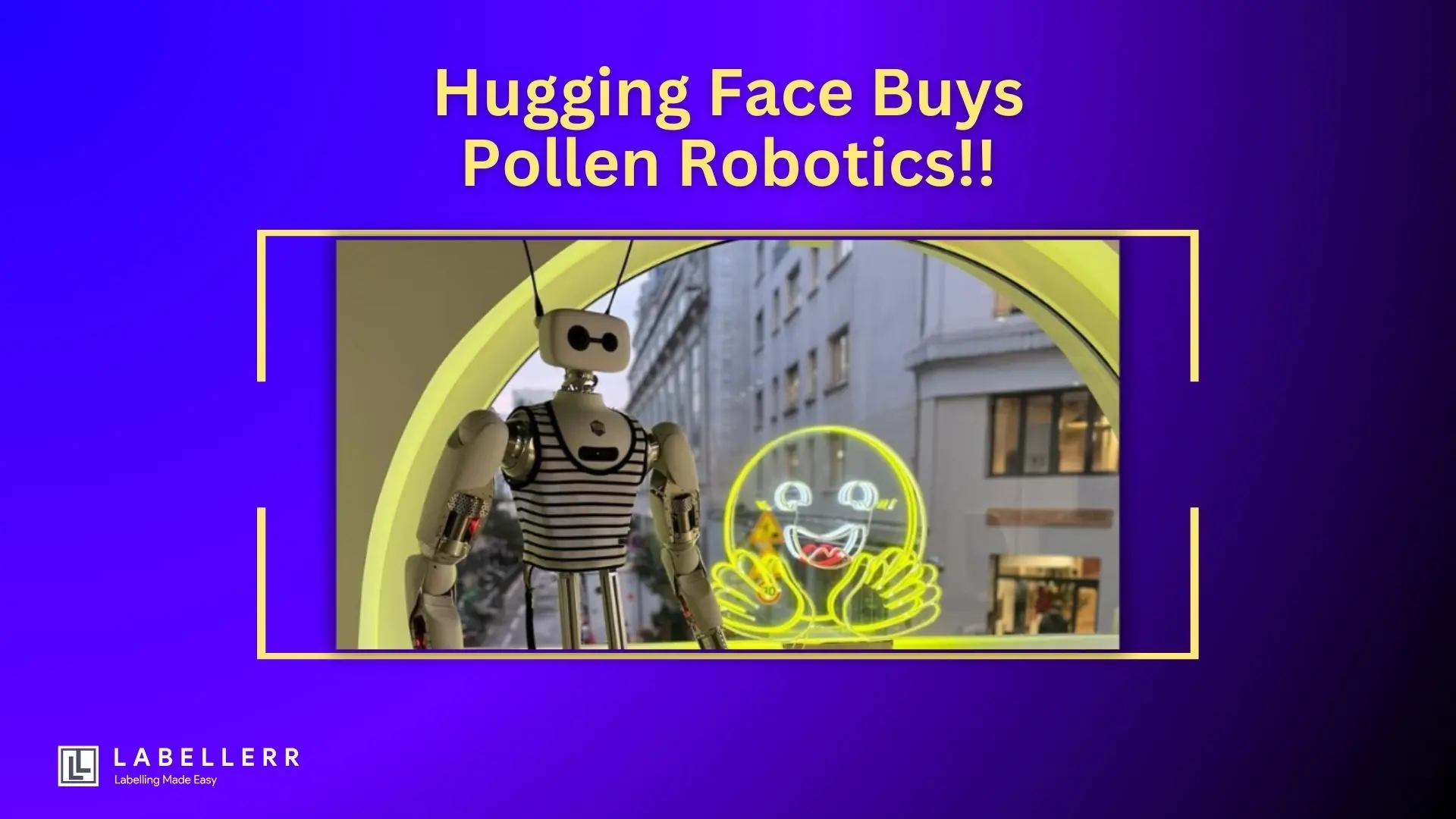Hugging Face Buys Pollen Robotics - Here’s the Impact
Hugging Face's acquisition of Pollen Robotics introduces Reachy 2, an open-source humanoid robot. This move aims to democratize robotics, making advanced AI-powered robots accessible for research, education, and innovation.

Exciting news is buzzing in the world of artificial intelligence (AI) and robotics! Hugging Face, a company many developers know and love for its huge online library of free AI tools and models, has just bought Pollen Robotics.
Pollen Robotics is a French startup famous for creating an open-source (meaning its designs are shared freely) humanoid robot called Reachy 2 .
Pollen Robotics, started in France in 2016 by Matthieu Lapeyre, Alice Coucke, and Pierre Rouanet, makes open-source robots.
Their main creation is Reachy 2. Their goal has always been to make robots open, ethical, and easy for people to access .
So, why is this a big deal? This purchase isn't just about one company buying another. It shows that Hugging Face is serious about taking its AI models out of the computer and putting them into physical robots that can move and interact with the world .
They want to make robotics open and available to everyone, just like they've done with AI software .
Let's explore what this means for the future of AI, how it might change robotics, and why everyday people should pay attention to this tech team-up.
Why is Hugging Face Getting into Robots?

Hugging Face Acquires Pollen Robotics
Hugging Face sees a big future for AI in the world of robotics.
Robots: The Next Big Thing for AI
They believe that robotics is the next major area where AI will make huge breakthroughs and change things .
Thomas Wolf, one of Hugging Face's co-founders, even thinks that giving AI a physical body in a robot could help solve some of the really tough problems on the path to creating human-like Artificial General Intelligence (AGI) .
Open Source for Robots
Hugging Face wants to use its successful open-source approach for robots too . CEO Clément Delangue says that being open is super important, especially when you're talking about physical systems like robots.
He explained, "When considering physical devices performing tasks in various environments, the level of trust and transparency I require is significantly greater than when interacting with software on my laptop" .
Making Robots for Everyone
Just as Hugging Face made AI models easy for millions to use, they now want to make building and using robots simpler and more affordable for all sorts of people – from students and hobbyists to researchers and businesses .
They dream of a future where anyone can "build or use robot assistants or games, starting from open solutions instead of closed, remote controlled, hardware" .
Building on Past Work
This move makes sense when you look at what Hugging Face has already been doing. In 2024, they started "LeRobot," an open-source robotics library led by Remi Cadene (who used to work on Tesla's Optimus robot) .
The LeRobot community grew very quickly, showing a lot of excitement for open robotics. They even worked with Pollen Robotics on "Le Robot," an open-source robot designed for household tasks, and on an affordable $100 robotic arm.
A Perfect Match
Pollen Robotics has always focused on open-source robots. Their co-founder Matthieu Lapeyre said, "Hugging Face is a natural home for us to grow, as we share a common goal: putting AI and robotics in the hands of everyone" .
Meet Reachy 2
Reachy 2 is the advanced, open-source humanoid robot created by Pollen Robotics that Hugging Face is now bringing into its family.
What Reachy 2 Looks Like
It has an upper body with big, expressive eyes, two arms, and a base with wheels so it can move around . It's designed for researchers, students, and anyone experimenting with "embodied AI" – that's AI that can interact with the physical world around it .
Reachy 2's Cool Features:
- Human-like Arms: Each arm can move in seven different ways, making them very flexible, much like a human arm . One arm can lift objects up to 3 kg (about 6.6 pounds) .
- Natural Movement: It uses a special joint system called "Orbita" that helps its neck and wrists move smoothly and expressively .
- Mobile Base: It can roll around on "Omni wheels" and uses LiDAR (a laser-based sensor) to help it navigate.
- Senses: Reachy 2 has stereo vision (two cameras that work like human eyes for depth perception), microphones to hear, and a speaker to make sounds.
- Remote Control with VR: People can control Reachy 2 from a distance using a VR headset. They can see what the robot sees through its cameras and guide its arms, hands, and head in real-time .
- Software: It runs on a common robotics software system called Robot Operating System 2 (ROS 2) and Hugging Face's own LeRobotHF framework. Developers can program it using the Python language .
- What It Can Do: Reachy 2 has been shown doing tasks like organizing coffee mugs and picking up fruit .
- Already Being Used: Reachy 2 isn't just an idea; it's a real robot that top research labs like Cornell University and Carnegie Mellon University are already using to study how humans and robots interact, machine learning, and complex tasks . It even won second place in a big robotics competition called the ANA Avatar XPRIZE in 2022 .
- The Price: Hugging Face plans to sell Reachy 2 for around $70,000 . While this is still a lot of money for an individual, it's a price that could make advanced humanoid robots more reachable for a wider range of researchers and schools compared to some other very expensive robot systems .
What Does This Deal Actually Mean?
This Hugging Face and Pollen Robotics team-up will have some big effects:
1. Hugging Face Now Sells Hardware
This is a big step for Hugging Face. They are known for AI software, but now they will also offer physical robots .
About 20-30 employees from Pollen Robotics, including its co-founders Matthieu Lapeyre and Pierre Rouanet, will join Hugging Face. They bring a lot of valuable experience in building hardware and robots .
This is Hugging Face's fifth company purchase, and the largest one in terms of new people joining their team .
2. Speeding Up Open-Source Robotics
Hugging Face plans to make Reachy 2 truly open. They will share the robot's hardware designs, software, and instruction manuals freely on their platform .
This means developers can download the plans, lists of parts, and 3D models. They can then repair, change, or even 3D print their own robot parts .
By opening everything up, Hugging Face hopes to build a large, active community around robotics, similar to the one they have for AI models. This can lead to new ideas and improvements happening much faster.
CEO Clément Delangue believes that being open source is key for building trust, especially with physical AI systems that interact with our world . It also allows people to see what robots can really do, cutting through some ofthe hype from staged demos .
3. Connecting AI Software with Physical Robots
This move will help better connect Hugging Face's powerful AI models (like those that understand language or see images) with physical robots .
Imagine robots that can understand your spoken commands more clearly, "see" and understand their surroundings more intelligently, and learn new tasks more easily by using the huge number of AI resources available on the Hugging Face Hub. Reachy 2 gives researchers a physical robot to experiment with "embodied AI" – AI that learns and acts through a physical body.
This is seen as a very important step towards creating more capable and general-purpose AI.
4. Making Advanced Robotics Easier for More People to Access
By offering an open-source humanoid robot and the tools to program it, Hugging Face wants to make it easier and cheaper for people to get started with advanced robotics .
This could help smaller research labs, universities, startups, and even individual hobbyists to work with humanoid robots. Right now, this field is mostly led by big, rich companies like Tesla, Figure, and Agility Robotics .
5. What Could Happen in the Future?
Hugging Face thinks there will be "massive growth" in personal AI robots. They even predict that at least 100,000 personal robots will be pre-ordered in 2025 .
Reachy 2 could be a platform for developing these kinds of personal assistants or companions. More accessible and intelligent robots could also find new uses in areas like healthcare, education, helping people with disabilities, customer service, and even entertainment .
Hugging Face's open approach also offers an alternative to the closed, proprietary systems from some other robot companies, which can lead to more new ideas and healthy competition.
Challenges and What to Keep an Eye On
While this is exciting, there are also challenges:
- Hardware is Complicated: Selling and supporting physical products like robots is very different and often harder than distributing software.
- Will People Buy It? Even if researchers are interested, will there be a big enough market for a $70,000 open-source humanoid robot? The market for humanoid robots is still new, and many uses for them are still being figured out .
- Competition: The robotics world is getting crowded, with many companies having a lot of money and resources.
- Real-World Performance: Being open source is great, but robots still need to work reliably and safely in messy, unpredictable real-world places.
Conclusion
Hugging Face buying Pollen Robotics is more than just a business move; it's a big statement about the future of AI and robotics.
They believe that an open, collaborative, community-focused approach can change robotics for the better, just like it has for AI software .
By bringing Reachy 2 and the Pollen Robotics team into their world, Hugging Face is building an important bridge between powerful AI models and the physical world we live in .
This has the potential to speed up new ideas, make advanced robotics available to more people, and ultimately, bring us closer to a future where intelligent robots play a bigger and more helpful part in our daily lives .
It’s an exciting development to watch as AI continues to learn, and now, to move.
FAQs
Q1: What is Reachy 2?
A: Reachy 2 is an open-source humanoid robot developed by Pollen Robotics. It features expressive movements, a friendly design, and is designed for intuitive human-robot interaction.
Q2: Why did Hugging Face acquire Pollen Robotics?
A: Hugging Face aims to democratize robotics by making advanced AI-powered robots like Reachy 2 accessible for research, education, and innovation.
Q3: What are the key features of Reachy 2?
A: Reachy 2 boasts seven degrees of freedom in its arms, an advanced Orbita joint system for expressive movement, and supports VR teleoperation for remote control.
Q4: Who can benefit from Reachy 2?
A: Researchers, educators, developers, and hobbyists interested in AI and robotics can utilize Reachy 2 for various applications, from academic research to real-world tasks.
Q5: How does this acquisition impact the robotics industry?
A: This move by Hugging Face promotes open-source development in robotics, fostering collaboration and accelerating innovation in the field.
References

Simplify Your Data Annotation Workflow With Proven Strategies
.png)


